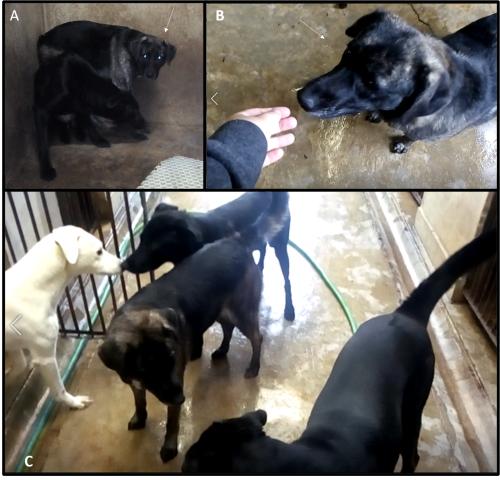Discussion
Social enrichment based on human interaction had positive effects on the dog’s body posture and position in the enclosure

- Supported by similar studies on shelter dogs
- The dogs began spending more time standing at the front, as opposed to being crouched at the back of their enclosure.
This was seen in our study with several of the strays including Branco, as we can see in Figure 18, his body posture changed from a crouched posture to a more relaxed body posture and when comparing still shots from the first general behaviour assessment and the last, there is a clear difference not only in body posture but also in the positioning of Branco in his enclosure.
Why is it Important?
- Welfare improvement by reducing the stress and the intense fear felt by the animals
- In agreement with similar studies on shelter dogs
- The dogs become more adjusted to the shelter environment
- The implementation of social training, in the long run, can increase the chances of adoption by potential adopters
- 72.5% of people visiting the shelter prefer dogs standing at the front of the enclosure compared to similar dogs remaining the back of their enclosure - Wells and Hepper (1992)
The unsocialized stray dogs approached unfamiliar humans more often with increased frequency of interactions
-Supported by previous studies on shelter dogs by Coppola, Grandin, & Enns (2006) and on village dogs by Ruiz-Izaguirre et al., (2014)
This was also observed with in the dogs of the Stray Group
Familiar person (Figure 19)
- This happened naturally over time as the strays were trained on a daily basis for almost 3 months, two of the dogs, Nina and Molly, presented similar behaviour of those in the control groups, the socialized dogs, as they received the familiar person with jumps and wagging tails and occasionally requests for petting.
Unfamiliar Person
- At the end of the social rehabilitation period, the strays dogs had very little contact with the unfamiliar person, mainly during the tests, so they were still apprehensive on approaching. However at a later stage, as the unfamiliar person helped with filming part of the leash training sessions, the stray dogs become more habituated to her presence and would increase their approach attempts towards de unfamiliar person.
- When questioned if any behaviour differences were noted, the shelter staff reported less fearful responses and even small positive interactions.

Conclusions
- Time of permanence in shelter does not seem to influence dog’s sociability with humans.
- There was a significant improvement on the stray dog’s sociability with the familiar person as a consequence of training and this improvement was translated to an unfamiliar person to the animals.
- The stray dog’s body posture improved across social rehabilitation sessions, as the dogs became less fearful and adopted a more neutral stance.
- The stray dogs gradually began standing in the front of their enclosure instead of being crouched in the back.
- There were no improvements on the strays leash test score for both familiar and unfamiliar person, as a consequence of leash training.
Responsible for this page:
Director of undergraduate studies Biology
Last updated:
06/02/20
